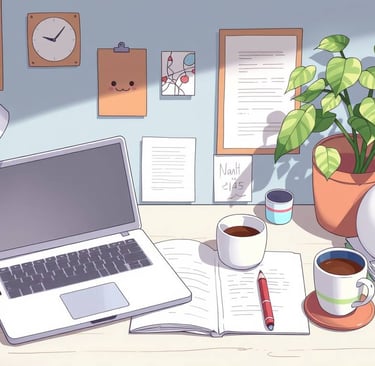How to Write an Amazon Short Story (Even If You’ve Never Written Before)
Blog postThis beginner-friendly guide walks aspiring authors through how to write and self-publish an Amazon short story—from first idea to final upload. Learn actionable tips, a simple writer’s blueprint, and personal insights to help you start writing confidently and consistently. Perfect for anyone with a story to tell but unsure where to begin.description.
Karen Andresen
6/5/20254 min read


If you’ve ever thought, “I have a story in me, but I don’t know how to start,” you’re in the right place.
Whether you’re dreaming of publishing your first Amazon Short Read or just want to get your ideas out of your head and onto the page, this guide will show you exactly how to write your first short story—from idea to upload.
And here’s the best part: you don’t need to be a professional writer. You just need a blueprint, a little time, and the willingness to start. I know, because I’ve been there. In fact, I recently completed a 30-day writing challenge and published a 20,000-word sci-fi/clean romance novella on Amazon in just a month.
Let’s break down how you can do the same.
Why Writing a Short Story on Amazon is the Perfect First Step
Publishing a novel can be overwhelming. But writing an Amazon short story—or a “short read”—is manageable and incredibly rewarding. Amazon even categorizes stories by how long they take to read, making it easier for readers to find quick, engaging content.
Benefits of starting with an Amazon Short Read:
Low word count (often under 30,000 words)
Easier and faster to write than a full novel
Helps build your confidence and writing habit
You can start earning passive income as a writer
You’ll join a growing niche of self-published authors
If you’ve always wanted to write, this is your perfect launchpad.
The Writer’s Blueprint: 7 Steps to Writing Your Amazon Short Story
Here’s a step-by-step writer’s blueprint to help you go from blank page to published.
1. Get Clear on Your Story Idea
You don’t need a perfect plot, but you do need a direction.
Start by answering a few simple questions:
Who is the main character?
What do they want?
What’s standing in their way?
What will change by the end?
💡 Example: I knew I wanted to write a sci-fi romance. I didn’t have a detailed plot at first, just the concept: What if an alien tech engineer fell for a human scientist during a planetary crisis?
Tip: Keep it simple. One main character, one goal, one conflict.
2. Outline—But Don’t Overdo It
Outlining helps you stay consistent, avoid writer’s block, and finish faster. But don’t fall into the trap of outlining forever.
Here’s a simple structure to follow:
Basic Short Story Outline:
Beginning – Introduce the character and their goal
Middle – Throw in challenges and conflicts
Climax – Things come to a head
Ending – Resolve the conflict and show change
If you’re new to outlining, don’t worry—I’ve got a free downloadable template coming soon!
3. Set a Realistic Word Count Goal
Amazon classifies short reads by reading time, so choose your word count based on how long you want your story to be.
Amazon Short Read
Approx. Word Count
15-minute read
3,000–5,000 words
30-minute read
7,000–10,000 words
1-hour read
12,000–15,000 words
2-hour read
20,000–25,000 words
Choose what fits your schedule and writing comfort. My 20k story took about an hour a day for 30 days.
4. Start Writing (Even If It’s Messy)
This is the part that stops most beginners. You worry it’s not “good enough.” But here’s the truth: you can’t edit a blank page.
Strategies to actually start writing:
Set a timer for 20 minutes and free-write
Use speech-to-text if you talk faster than you type
Write scenes out of order if it helps
Consistency beats perfection. Write a little every day, even if it’s only 200 words.
5. Embrace Editing (But Not While Drafting)
Once you’ve finished your first draft, then it’s time to refine.
What to focus on during editing:
Clarify your character’s arc
Cut unnecessary scenes
Strengthen dialogue and pacing
Fix spelling, grammar, and formatting
You can use free tools like Grammarly or the Hemingway App to polish your story. Or, ask a trusted friend or beta reader for feedback.
6. Format and Publish on Amazon
Once your story is edited, you’re ready to format it for Amazon Kindle. You can use free tools like Reedsy’s Book Editor or even format in Word and export as a .docx or .epub file.
To publish:
Create an Amazon KDP account
Upload your manuscript and cover
Choose your categories and keywords
Set a price (short reads often range $0.99–$2.99)
In just a few clicks, your story can go live for the world to read.
7. Market and Celebrate!
You don’t need a big platform to start. Share your story on your personal social media, writing groups, or even through a simple landing page.
Bonus Tips:
Add a compelling description with keywords like “sci-fi short read” or “clean romance”
Ask readers to leave a review
Join Amazon author groups on Facebook or Reddit for support
Common Questions About Writing Your First Amazon Short Story
“What if I’m not a ‘real’ writer?”
You are the moment you write. Don’t wait for permission. Every successful author started somewhere.
“What if I don’t finish?”
Start smaller. Aim for a 15-minute read. Momentum builds confidence.
“How do I stay motivated?”
Track your word count. Set deadlines. Use accountability buddies or join a writing challenge. That’s how I hit 20k in 30 days!
Final Thoughts: Just Start Writing
You don’t need to be perfect. You just need to write. Your voice matters, your story matters, and someone out there is waiting to read it.
Writing and publishing a short story on Amazon is totally doable—even if you’ve never written a thing before. Use this writer’s blueprint as your guide, and take it one step at a time.